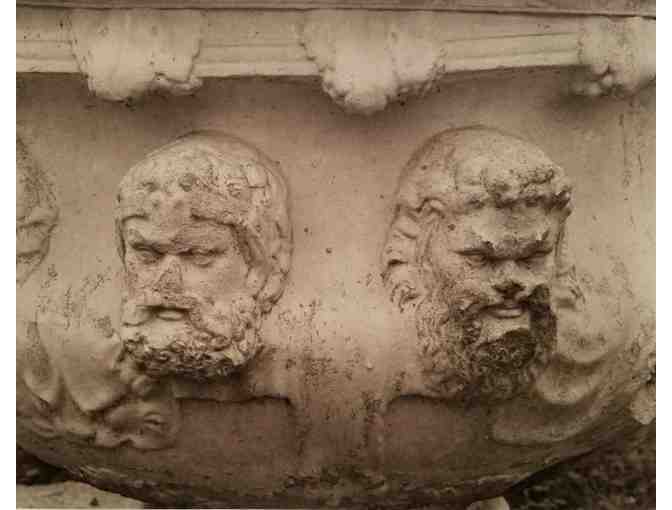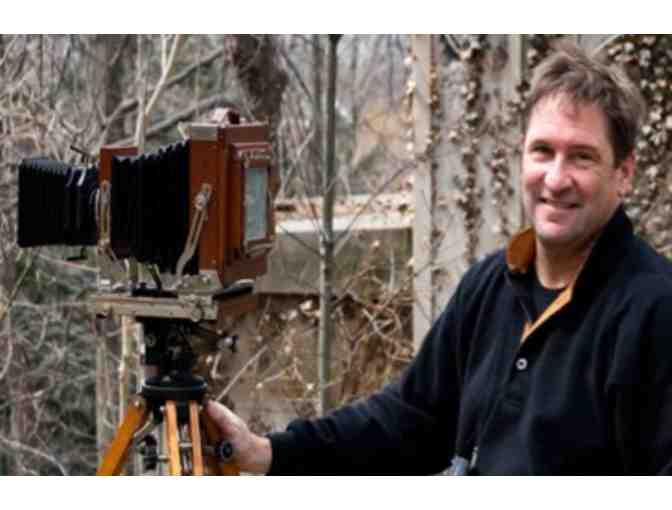Sutro Heights 8"x10" Platinum/Palladium Print by Photographer Peter Spangenberg

Item Number: 535
Time Left: CLOSED

Description
This photograph of Sutro Heights is one of a portfolio of images documenting the landscape and artifacts littering the remains of both Sutro Baths and Heights. It is an 8"x10" Platinum/Palladium print (see special note below for more information) from Peter Spangenberg, uncle of Andrew (6th) and Stuart (4th).
In the 1880’s Adolph Sutro decorated his garden with over 200 concrete replicas of Greek and Roman statuary, planters and benches imported from Belgium with the express intent of sharing examples of European culture with his San Francisco visitors. The image shows one of the few remaining original concrete urns in the park, and it only recently has been printed in platinum/palladium. Although this portfolio was originally printed in gelatin silver, Peter has revisited several of these negatives and printed them in platinum because the process more eloquently conveys the mood of the place and the softness of the morning light and fog that customarily envelop that part of San Francisco.
Peter Spangenberg lives and works in Chagrin Falls, Ohio. He studied photography at Stanford University under the guidance of Joel Leivick and Laura Volkerding, and has received feedback and training from some of the giants of modern photography including Richard Misrach, Michael Kenna, Lois Conner, Linda Connor, Morley Baer, Roy DeCarava, Robert Heinecken, Philip Trager, and Ansel Adams.
Peter’s work, partly because of where he studied and practiced his craft, has been heavily influenced by the West Coast Photography Movement. Subject matter is usually limited to landscapes, architecture, or abstractions of both. His photographs often show evidence of human interaction with the land, but are frequently presented to viewers as an “empty stage” so that they can immerse themselves in the calm, and draw personal meaning from the subject as it has been presented. He works exclusively with large format cameras (4”x5”, 5”x7” and 8”x10” negatives), and all prints are created in a wet darkroom. His sensitivity to form, texture, tonal gradations, and the quality of the light has led him to pursue the alternative process of Platinum/Palladium printing to best highlight these elements of his vision.
Special Instructions
Pick up at school or additional shipping charges will apply. For more information on Peter Spangenberg and platinum/palladium prints, please go to: http://www.thelatentimage.info/
A special note about Platinum/Palladium printing and the paper used for this image. Platinum prints are the most durable of all photographic processes as both platinum and palladium are quite stable against chemical reactions that might degrade the image. It is estimated that a platinum image, properly made, can last thousands of years. Some of the desirable characteristics of a platinum print include:
- A non-reflective surface of the prints.
- A delicate, large tonal range, particularly in the mid-range.
- The light sensitive material sits in the paper rather than in a gelatin coating on the surface of the paper.
- A greatly decreased susceptibility to deterioration.
This printing process was perfected in 1873 by the British inventor William Willis. Willis introduced the "hot bath" method where a sensitizer composed of ferric oxalate, platinum and/or palladium, and sodium chloroplatinate is coated onto paper which is then exposed through a negative and developed in a warm solution of potassium oxalate. As a practical matter, the ferric oxalate provides the light sensitivity. The iron salt responds to exposure to UV light, and, upon exposure to UV light, it reduces to ferrous oxalate. It is later, in development, that the platinum and palladium attach themselves to the exposed iron particles to make the Pt/Pd print. Unused iron and metal salts are then cleared using a combination of citric acid and ethylenediaminetetraacetic acid (EDTA).
This image is printed on Weston Diploma Parchment paper. The print was contact printed using an “in camera” 8x10 inch negative.